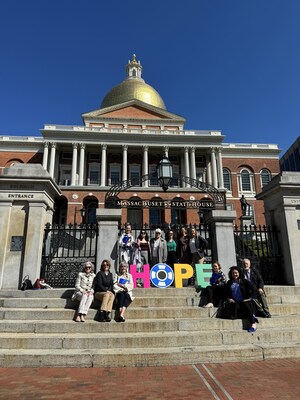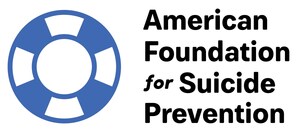NEW YORK, Aug. 12, 2024 /PRNewswire/ -- The Centers for Disease Control and Prevention (CDC) released its Youth Risk Behavior Survey Data Summary & Trends Report: 2013–2023, which provides data on health behaviors and experiences of high school students in the United States. This report highlights students' behaviors and experiences in 2023, changes from 2021 to 2023, and 10-year trends.
The American Foundation for Suicide Prevention (AFSP), a leading suicide prevention organization, releases the following statement regarding the CDC's data:
The recent findings from the CDC underscore the continuing and critical need to prioritize youth mental health and suicide prevention efforts. At AFSP, our work to support youth mental health consists of prevention strategies that range from research to inform our work, community education, promoting opportunities for connection, and advocacy for healthcare level efforts. The improvements from 2021-2023 offer a glimmer of hope and show that change is possible, but the decade-long trends in the report remind us of the ongoing challenges and complexities in suicide prevention efforts.
According to the report, from 2021 to 2023, there were decreases in:
- The percentage of female students who felt persistently sad or hopeless (from 57% to 53%), and who seriously considered attempting suicide (from 30% to 27%).
- The percentage of Hispanic students who felt persistently sad or hopeless (from 46% to 42%), who experienced poor mental health (from 30% to 26%), who seriously considered attempting suicide (from 22% to 18%), and who made a suicide plan (from 19% to 16%).
- The percentage of Black students who attempted suicide (from 14% to 10%) and who were injured in a suicide attempt (from 4% to 2%).
Other noteworthy findings:
- Nearly all measures of poor mental health and suicidal thoughts and behaviors have worsened from 2013 to 2023. This includes a rise in the percentage of students reporting persistent feelings of sadness or hopelessness, those seriously considering suicide, planning suicide, and attempting suicide.
- There are continuing disparities across groups of youth. In 2023, LGBTQ, American Indian/Alaska Native and female students were more likely to experience persistent feelings of sadness or hopelessness, poor mental health, and suicidal thoughts and behaviors. LGBTQ youth are more likely to experience all forms of violence; differences in mental health compared to peers are substantial. More than 3 in 5 LGBTQ students experienced persistent feelings of sadness or hopelessness and 1 in 5 attempted suicide during the past year.
- Two in 10 students seriously considered attempting suicide and nearly 1 in 10 students reported attempting suicide in 2023. Based on national CDC mortality data, in 2022, suicide rates among adolescents and young adults aged 15 to 24 decreased by 10% from 15.2 to 13.6 and we hope this trend continues.
Note: The data do not explain the differences by race, gender, sexual orientation and their intersections or continued higher levels of poorer mental health and suicidal thoughts and attempts.
Each of us has a role in supporting the mental well-being of those around us. We encourage parents, teachers, coaches, community leaders and health professionals to review and share these resources to learn how they can help youth and teens with mental health and suicide prevention.
- How to Help: AFSP's tips for what to do when you are worried someone is at risk for suicide.
- School Resources: There is a strong correlation between students who feel more connected in school environments and their academic performance and mental health. Building schools' capacity to support student mental health is imperative, AFSP has a multitude of school resources for students, parents and administrators to build positive mental health in school communities such as the Model District School Policy for Suicide Prevention, It's Real program for youth and More Than Sad for parents and educators.
- Campaigns for Youth: In partnership with the Ad Council, AFSP's Seize the Awkward campaign "We Can Talk About It" encourages young people to push past pervasive taboos, misconceptions and negative attitudes about mental health and reach out to a friend who may be struggling.
- Advocacy: Protective actions like increasing acceptance and affirmation of LGBTQ identities, reducing anti-LGBTQ prejudice, and increasing access to LGBTQ-affirming physical and mental health care reduce the likelihood of LGBTQ youth suicidal thoughts and promote wellbeing. Join our efforts in ensuring positive and affirming school environments for all students here.
- Healthcare Efforts: The American Academy of Pediatrics (AAP) and AFSP, in collaboration with experts from the National Institute of Mental Health (NIMH), created this Blueprint for Youth Suicide Prevention as an educational resource to support pediatric health clinicians and other health professionals in identifying and advancing equitable youth suicide prevention strategies in all settings where youth live, learn, work, and spend time.
We encourage media to consider these ethical reporting recommendations to minimize hopelessness and to increase help-seeking when covering this news and topics related to suicide.
The American Foundation for Suicide Prevention is dedicated to saving lives and bringing hope to those affected by suicide, including those who have experienced a loss. AFSP creates a culture that's smart about mental health through public education and community programs, develops suicide prevention through research and advocacy, and provides support for those affected by suicide. Led by CEO Robert Gebbia and headquartered in New York, with a public policy office in Washington, D.C., AFSP has local chapters in all 50 states, D.C. and Puerto Rico, with programs and events nationwide. Learn more about AFSP in its latest Annual Report and join the conversation on suicide prevention by following AFSP on Facebook, Twitter, Instagram, YouTube, LinkedIn and TikTok.
Media interested in commenting on this news are encouraged to fill out this press request form and review AFSP's Ethical Reporting Tips.
SOURCE American Foundation for Suicide Prevention

WANT YOUR COMPANY'S NEWS FEATURED ON PRNEWSWIRE.COM?
Newsrooms &
Influencers
Digital Media
Outlets
Journalists
Opted In






Share this article